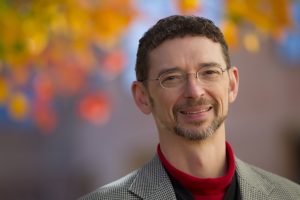

In Ewing sarcoma, cancer cells’ DNA is unwound abnormally from a condensed, compact state. Once sections of genetic code are open, key genes are turned on to help direct aggressive and cancerous cell growth.
In a first-of-its-kind-study, researchers at the University of North Carolina Lineberger Comprehensive Cancer Center discovered and applied a new screening technique capable of testing thousands of potential drug compounds to see if those compounds can reverse abnormal DNA unwinding in Ewing sarcoma, a bone and soft tissue cancer that’s most common in teens and young adults.
In a preclinical study published in the journal Proceedings of the National Academy of Sciences, researchers report that their screening technique identified a group of drug compounds that was particularly active in their cell model of Ewing sarcoma. More broadly, the researchers say they’ve shown proof of concept of a drug screening strategy that could be applied for an array of cancers.
“This is exciting because we have identified an overall strategy for discovering new drugs based on the signature of how DNA is packaged,” said Ian J. Davis, MD, PhD, G. Denman Hammond Associate Professor in Childhood Cancer, a UNC Lineberger researcher, and an associate professor in the UNC School of Medicine Departments of Pediatrics and Genetics.
Most patients with Ewing sarcoma have a DNA mutation in their cancer cells that creates a completely new gene called EWSR1-FLI1. In a discovery led out of UNC-Chapel Hill in 2012, researchers found that this mutant gene creates a protein that travels to unexpected spots along the genome, causing it to unwind abnormally.
Researchers built on that finding to create a lab test reflecting the unique signature of DNA packaging in Ewing sarcoma. In this test, they only examined sections of chromatin that are unwound in the cancer cells, but not in normal cells.
“There are characteristic regions where this oncogene goes in Ewing sarcoma to open up regions of DNA,” said Davis, a cancer researcher and pediatric oncologist at the N.C. Cancer Hospital. “So this offers us a unique signature for this cancer, one that is not observed in other cancers, creating an opportunity to use it in our new screen.”
Drawing upon a specialized library of small molecule compounds in the UNC-Chapel Hill Center for Integrative Chemical Biology and Drug Discovery, part of the UNC Eshelman School of Pharmacy, they tested hundreds of small molecules against their cellular model to see if the compounds restored normal chromatin structure. The library contains more than 1,000 compounds that were previously developed at UNC to target chromatin regulation as well as chromatin-targeted compounds acquired from other developers.
Through the test, they found that a class of compounds called histone deactylase inhibitors reduced chromatin accessibility at targeted sites. That class has been identified previously as a potential treatment for Ewing sarcoma, Davis said, but they also identified other novel molecules that were active in their screen.
The study’s findings further validate the strategy of targeted drug discovery, said study co-author Stephen Frye, PhD, Fred Eshelman Distinguished Professor in the UNC Eshelman School of Pharmacy, a UNC Lineberger member, and the director of the drug discovery center.
“We could go and screen small molecules to just try to kill cancer cells, but lots of compounds that will kill cells are not interesting or worthwhile to pursue as drugs,” Frye said. “In this case, we’re screening for activity of these drugs against a specific chromatin structural defect that we know is unique to Ewing sarcoma.”
Frye added that their strategy opens the door for testing of chromatin altering drugs in other cancers.
“There is a huge, less explored class of compounds that we have designed to regulate chromatin,” Frye said. “What’s novel and interesting about our screening approach is we can test them without having to figure out every last detail about what goes wrong at a molecular level in Ewing sarcoma. We can simply say, we know there is a chromatin defect that’s specific to this disease, and we have compounds that regulate chromatin, we can screen that set looking for a specific change in chromatin structure and then test active compounds for activity in models of cancer.”
The researchers believe this screening approach might work in other cancers.
“We wanted to know if you can develop a screen that uses chromatin as a way of identifying small molecule drugs for cancer. The answer is yes, you can,” Davis said. “If we can get this to work in one disease that has a very distinct profile for how DNA is packaged, maybe we can get it to work to identify potential drugs in other cancers.”
The study was supported by the Wide Open Charitable Foundation, the V Foundation for Cancer Research, the National Institutes of Health, the Carolina Partnership, and the University Cancer Research Fund.
In addition to Davis and Frye, additional co-authors include: Samantha G. Pattenden of the UNC Center for Integrative Chemical Biology and Drug Discovery of the Eshelman School of Pharmacy Division of Chemical Biology and Medicinal Chemistry; Jeremy M. Simon of UNC Lineberger, the UNC School of Medicine Department of Genetics, the UNC Curriculum in Bioinformatics and Computational Biology; Aminah Wali of UNC Lineberger, the UNC School of Medicine Department of Genetics, and the UNC Curriculum in Genetics and Molecular Biology; Chatura N. Jayakody of the UNC Center for Integrative Chemical Biology and Drug Discovery; Jacob Troutman of UNC Lineberger and the UNC Department of Pediatrics; Andrew W. McFadden of UNC Lineberger; Joshua Wooten of the UNC Department of Genetics, UNC Lineberger and the UNC Curriculum in Genetics and Molecular Biology; and Cameron C. Wood of the UNC Center for Integrative Chemical Biology and Drug Discovery.
